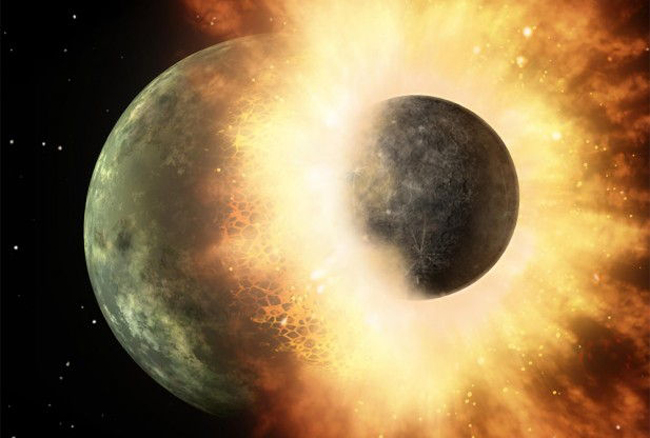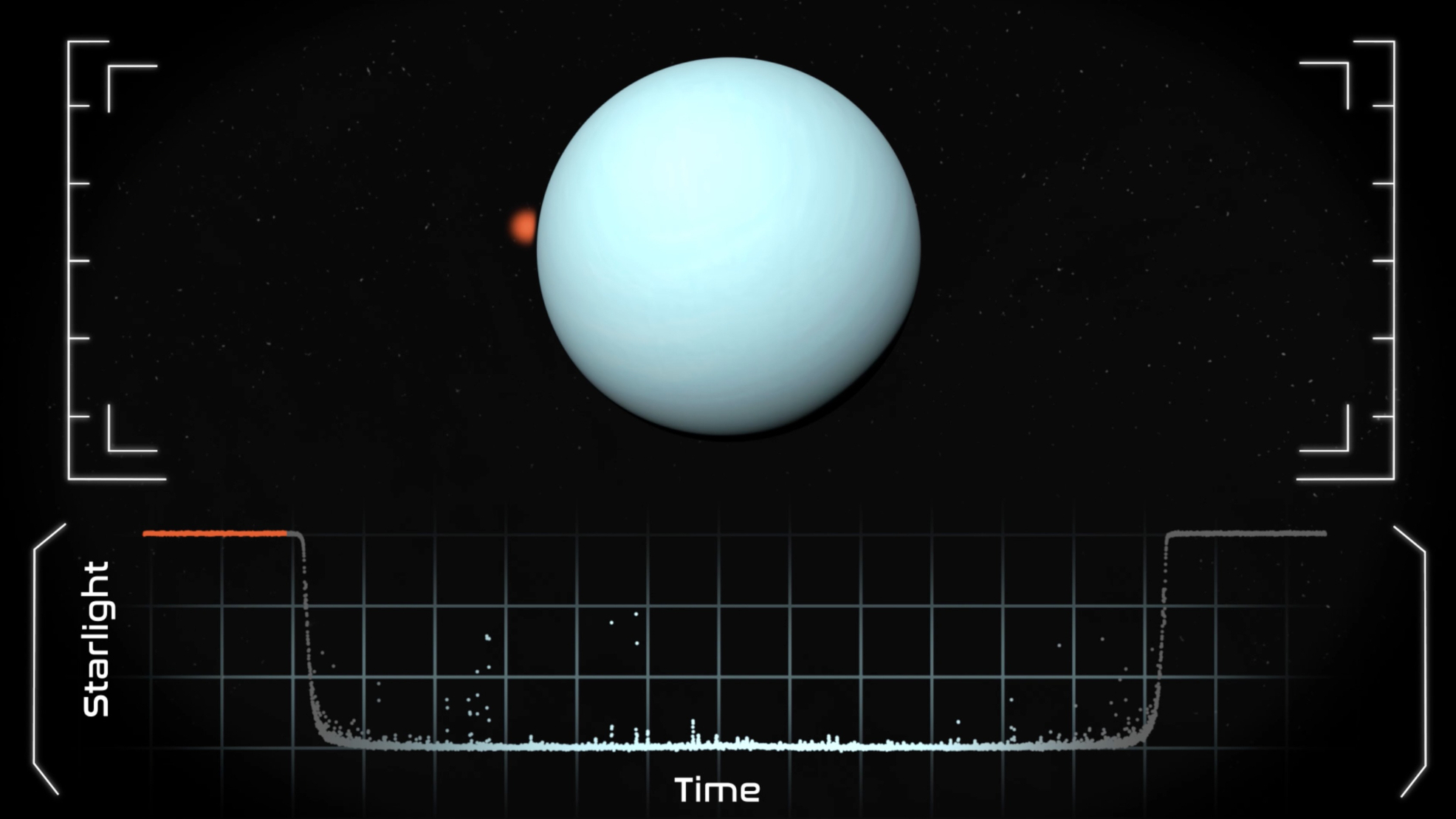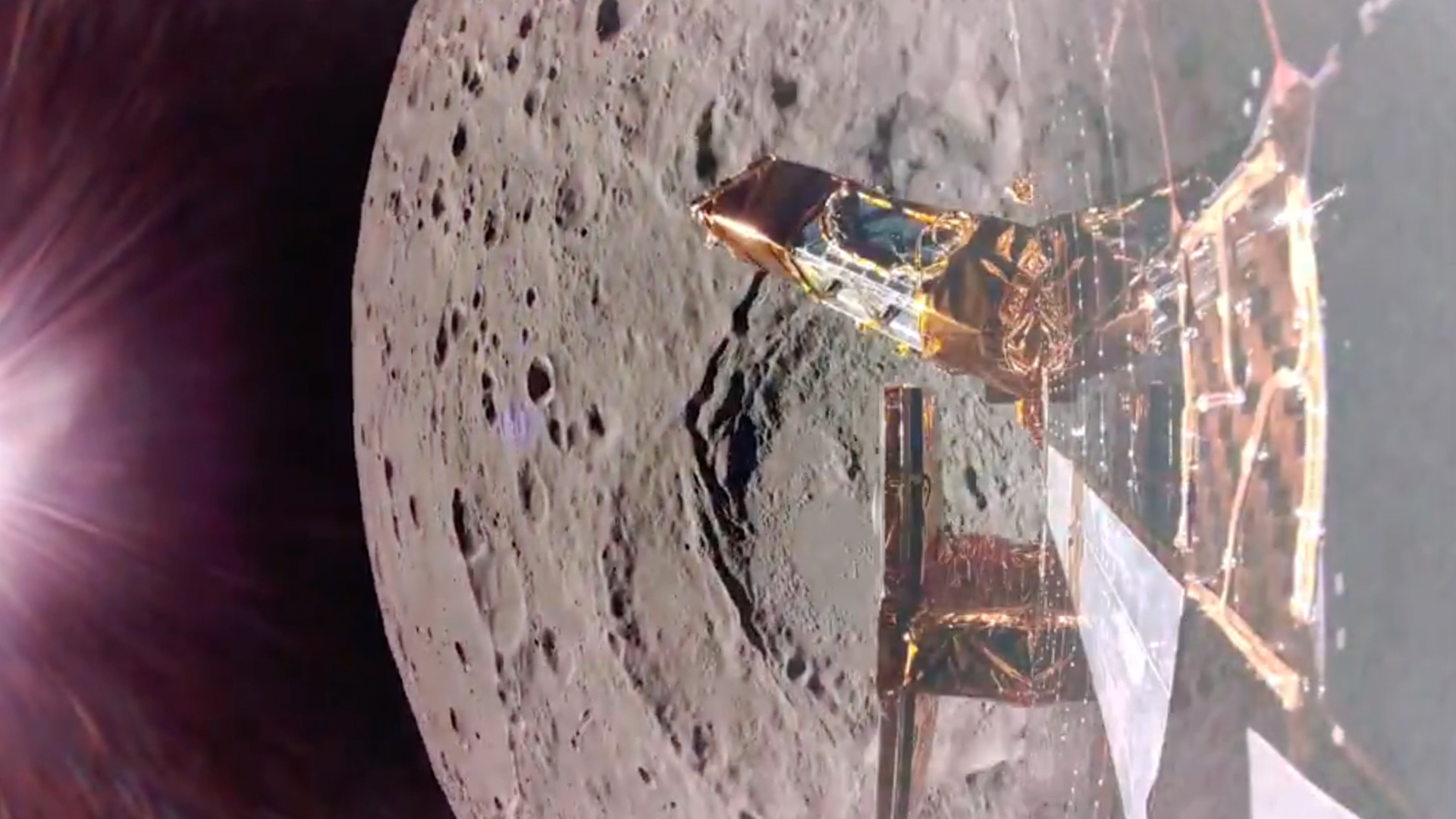Giant Moon-Forming Impact On Early Earth May Have Spawned Magma Ocean

LONDON — Billions of years ago, the Earth's atmosphere was opaque and the planet's surface was a vast magma ocean devoid of life.
This scenario, says Stanford University professor of geophysics Norman Sleep, was what the early Earth looked like just after a cataclysmic impact by a planet-size object that smashed into the infant Earth 4.5 billion years ago and formed the moon. The moon, once fully formed, which would have appeared much larger in the sky at the time, since it was closer to Earth
Hundreds of millions of years later, he added, the first forms of life appeared, possibly having hitched a ride on a rock from Mars. The scenario is one presented by Sleep at a recent Royal Society conference here called Origin of the Moon. A paper detailing Sleep’s study was submitted to the symposium volume. [The Moon: 10 Surprising Lunar Facts]
Although many elements of the theory have been around for some time, Sleep's synthesis is "like putting together a jigsaw puzzle with some pieces already known and some that are speculative and have new aspects," said Dave Stevenson, a Caltech professor of planetary science who was not involved with Sleep's study.
One of these new aspects is how Earth cooled down to the temperatures necessary for life to evolve, following the — presumed — giant impact that formed the moon.
The processes Sleep discussed took place in the period called Hadean, about 4 billion to 4.5 billion years ago — before the first organisms came into being, and well before more complex life-forms, including dinosaurs, started roaming the Earth.
Back then, the Earth was nothing like the blue Earth we know today.
Get the Space.com Newsletter
Breaking space news, the latest updates on rocket launches, skywatching events and more!
Scorching world
Instead, the entire Earth was hot and molten all the way to its inner core, a mixture of molten rock and liquid.
No life would have been able to survive these brutally high temperatures, which reached 2,000degrees Celsius (more than 3,600 degrees Fahrenheit). Liquid water had no chance to form.
The Earth's atmosphere at this time was also much heavier. Its mass was similar to that of today's oceans, and it pushed down on Earth's surface with a pressure of hundreds of bars. (For comparison, the average pressure at the Earth's surface today is 1 bar). It was also opaque — "you would not have been able to see much, just clouds covering everything," Stevenson said.
Beneath the clouds, a magma ocean swayed, with partially molten rock pushed around by tides, Sleep thinks.
These tides were due to the mutual attraction of the Earth and the moon, and were much stronger than those in today’s watery oceans, as the moon was sitting much, much closer to the Earth back then.
The tides constantly stirred the ocean, causing the mantle to lose heat, similar to stirring and blowing on a bowl of soup. But once released from the Earth's depths, the heat was trapped at the surface, held back by the thick, opaque primordial atmosphere.
The heat could only escape the planet (and cool it down) at so-called cloud-top temperature levels — where it would be as cold as on a modern high mountain summit. But for the first 10 million years, the temperatures were much, much higher, Sleep said.
The energy loss caused by the mutual attraction of the Earth and the moon was also making the moon gradually pull away. This made the tides progressively weaker, so the molten rock was being stirred less and less, and the Earth's mantle began to solidify in stages.
"While at the top of the Earth there was still partially molten slurry with a bit of liquid left, in the middle there was a mushy layer, but the deep mantle was becoming solid,” Sleep said. "Lava was probably still coming up and erupting and freezing at the top, and then falling back in large, kilometer-size pieces that were sinking into the Earth."
Slowly, the internal heat flow ceased to dominate the climate, and the temperatures at the surface began to drop, with the heat being able to escape the atmosphere at last.

Life from Mars?
The sweltering temperatures and trapped heat were not the only obstacles for life to appear, Sleep said.
Another issue was overabundance of carbon dioxide in the primordial atmosphere. Carbon dioxide doesn't dissolve in molten rock, so it was bound to bubble up from the magma ocean, creating a so-called runaway greenhouse effect, Sleep said.
For the Earth to become habitable, most of this carbon dioxide had to vanish.
Sleep said this happened when the tectonic plates began to move in the late Hadean, some 4.4 billion years ago. With the plates moving, the carbon dioxide began to enter the mantle in a process called subduction, when one tectonic plate moves under another and sinks into the mantle.
Liquid water oceans had already begun to condense around that time, and once the Earth cooled sufficiently and most of the carbon dioxide was safely tucked away in the mantle, life did finally appear, Sleep said, adding that chances are that this life arrived on Earth from Mars.
"We know life was present on Earth about 3.9 billion years ago, but Mars was probably habitable for a long time before the Earth," Sleep said. "So you had hundreds of millions of years when Mars was not a particularly unpleasant place, with liquid water. If life evolved on Mars, rocks get knocked off by asteroids all the time — so at some point, a rock from Mars could've come in, trying to hit us on the head." [When Space Attacks: The 6 Craziest Impacts]
And if conditions on Earth were just right for life to start, this Martian rock could've been the beginning of everything we know today.
But it’s still only an idea, yet a testable one. Unlike Earth, though, the ancient geological record exists on Mars, Sleep said. It is just hard to examine.
Follow Katia Moskvitch on Twitter @SciTech_Cat. Follow us @Spacedotcom. We're also on Facebook and Google+. Original article on Space.com.
Join our Space Forums to keep talking space on the latest missions, night sky and more! And if you have a news tip, correction or comment, let us know at: community@space.com.
Katia Moskvitch is a freelance science writer based in Switzerland currently serving as the head of communications for IBM Switzerland. She an award-winning writer who has covered astrophysics and other topics for Space.com, with her work also appearing in Quanta Magazine, Science, Wired, BBC News, Scientific American and The Economist among others.
In 2019, Katia was named European Science Journalist of the Year as well as British Science Journalist of the Year, and her book "Neutron Stars: The Quest to Understand the Zombies of the Cosmos" was published by Harvard University Press in September 2020. Katia holds a bachelor's degree in mechanical engineering from McGill University and master's degrees in journalism from the University of Western Ontario and in theoretical physics from King's College in London. She is fluent in English, French and Russian.









